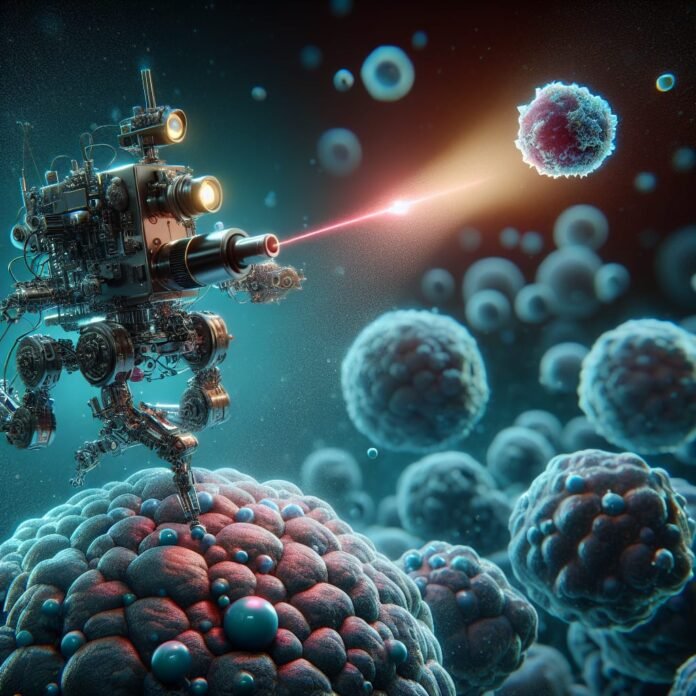In a groundbreaking breakthrough, researchers at Karolinska Institute have successfully developed nanorobots that selectively target and kill cancer cells in mice while leaving healthy cells intact. This innovative technology, published in the esteemed journal Nature Nanotechnology, holds immense promise for cancer treatment.
The Hidden Weapon
Led by Professor Björn Högberg, the research team employed DNA origami to create nanoscale structures that conceal a lethal peptide weapon. This hexagonal nanopattern of amino acid chains becomes deadly when exposed to the acidic microenvironment surrounding cancer cells.
“We’ve essentially created a ‘kill switch’ that activates only in the presence of cancer cells,” explains Professor Högberg. “By hiding the weapon inside a DNA-based nanostructure, we’ve overcome the challenge of indiscriminate cell killing.”
Targeted Cancer Destruction
The nanorobot’s activation mechanism relies on the acidic pH (6.5) characteristic of solid tumors. In test tube experiments, the researchers demonstrated that the peptide weapon remains concealed at normal pH levels (7.4) but unleashes its cell-killing potential when exposed to acidic conditions.
Successful Mouse Trials
When injected into mice with breast cancer tumors, the nanorobots achieved a remarkable 70% reduction in tumor growth compared to controls. This significant result underscores the potential of targeted cancer therapy.
Next Steps and Future Directions
While these findings are encouraging, the researchers acknowledge the need for further investigation. “We must test our nanorobots in more advanced cancer models that mimic human disease,” notes Yang Wang, the study’s first author. “Additionally, we’ll explore ways to minimize side effects and enhance targeting specificity.”
Enhancing Targeting Capabilities
To improve the nanorobot’s homing abilities, the team plans to incorporate proteins or peptides that selectively bind to specific cancer types.
Funding and Patent
This pioneering research was supported by the Knut and Alice Wallenberg Foundation, the European Research Council (ERC), the Swedish Research Council, and the Academy of Finland. The invention will be patented, paving the way for potential clinical applications.
Implications and Future Prospects
This breakthrough has far-reaching implications for cancer treatment. By harnessing the power of DNA origami and targeted nanotherapy, researchers may soon be able to:
Develop more effective cancer treatments with reduced side effects.
Enhance targeting capabilities for specific cancer types.
Improve patient outcomes and quality of life.
As scientists continue to refine this technology, the prospect of conquering cancer becomes increasingly hopeful.
Here are 5 p’tenti’l opinions and reactions from cancer patients:
Opinion 1: Hope and Renewed Optimism
“I’ve been living with breast cancer for years, and the thought of a treatment that can target cancer cells without harming healthy tissue is incredibly hopeful. This breakthrough gives me renewed optimism for my future.” Kakoli, 45, breast cancer patient.
Opinion 2: Eager for Human Trials
“I’ve undergone multiple treatments, but the side effects have been debilitating. The idea of targeted therapy with minimal side effects is a game-changer. I’m eager to see this technology advance to human trials.” Chandrani, 56, cancer patient.
Opinion 3: Concerns about Accessibility
“I’m thrilled about the potential of nanorobots in cancer treatment, but I worry about accessibility. Will this treatment be available to all patients, regardless of income or location? We need to ensure equal access to lifesaving technologies.” Remo, son of a cancer patient.
Opinion 4: Gratitude for Research Advancements
“I’ve lost loved ones to cancer, and seeing research advancements like this brings tears of joy to my eyes. Thank you to the researchers and funders who are working tirelessly to conquer cancer. This gives me hope for future generations.” Shibani, 40, cancer survivor
Opinion 5: Caution and Realistic Expectations
“While this breakthrough is exciting, I’m trying to remain cautious. We’ve seen promising treatments before that didn’t pan out. I’m hopeful, but I also understand that there’s still much work to be done before this becomes a viable treatment option.” Pallabi, daughter of a late cancer patient.
These opinions and reactions reflect a range of emotions and concerns from cancer patients, including hope, optimism, eagerness, concern about accessibility, gratitude, and caution.
Karolinska Institutet’s groundbreaking research has brought us closer to a future where cancer is no longer a life-threatening disease. With continued innovation and collaboration, the possibilities for targeted cancer treatment seem limitless.
By Anusmita Bhatta
Reporting for True To Life News Media Pvt. Ltd.
